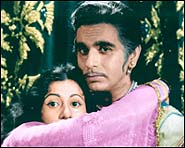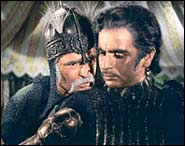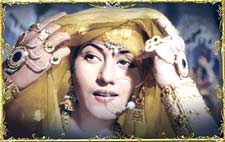 The most superlative line of work in Mughal times just has to be that of Royal Messenger. Scampering up to the Maharani and whispering that the inappropriate courtesan her son's been not-so-princely eyeing has developed an unsightly pimple is likely to make the dowager bestow a smile. Accompanied by an emerald ring the size of Ferozabad. Appropriately, the underlings scurry excitedly like rampant dormice as Shehzada Salim prodigally returns home, each taking turns to gift the queen with a slice of breaking news, each competing for greater bejewelled accoutrement. And then, as the heir-è-Hindustan does actually arrive, pearls are showered. Literally.
The most superlative line of work in Mughal times just has to be that of Royal Messenger. Scampering up to the Maharani and whispering that the inappropriate courtesan her son's been not-so-princely eyeing has developed an unsightly pimple is likely to make the dowager bestow a smile. Accompanied by an emerald ring the size of Ferozabad. Appropriately, the underlings scurry excitedly like rampant dormice as Shehzada Salim prodigally returns home, each taking turns to gift the queen with a slice of breaking news, each competing for greater bejewelled accoutrement. And then, as the heir-è-Hindustan does actually arrive, pearls are showered. Literally.
This is the richest Indian film in history, and every celluloid frame is soaked thoroughly with opulence. It is an epic not merely by virtue of the timeless story it tells, but also because of the tremendous tribulations its creation entailed. It is awesomely, stunningly overwhelming, a magnificent spectacle entirely free of CGI and nonlinear gimmickry, a gargantuan feat of of well, of Mughal proportions! From the sets  sweeping, regal palaces, courtyards and sandscapes, dungeons and escape routes  to the costumes to the innumerable extras, Mughal-e-Azam is undeniably a cinematic classic, standing a monumental testament to director K Asif's vision and commitment.
There is a lot of history in the making of Mughal-e-Azam, in fact enough stories to make a really good biopic! K Asif uncompromisingly and doggedly championed his film's cause, finally completing it over a ten-year period, which included the unlikeliest of hurdles, like his lead actors actually passing away (Asif's first stab with the film was as early as 1944, with Chandermohan, Nargis and Sapru, but was shelved when the leading man passed away in 1946, giving way to the eventual cast), and obviously going several times over the initial budget! Understandable, seeing he paid Bade Ghulam Ali Kham sa'ab Rs. 25,000 for a song [who else could sing for Tansen?] when the going rate for the Rafis and Latas was Rs. 300-400!
|
|||||||||||
This is the first time in the world that a colourised film has been theatrically released, and the expectations are enormous. Not impressed with the few colour rushes showing on television, I anticipated a flick paling in comparison to the original striking black and white, also a film I must confess I've seen only in tiny chunks and some snatches of song. I walked in, the credits rolled, and I reeled. The colourisation process, something I've been extremely dubious about, has worked fabulously, lending itself perfectly to the feel of the film. The colour doesn't obviously look like the standard fare we're used to, but it brilliantly complements the film: its like looking at an old film print through vaguely coloured glasses. There are moments where it does seem entirely natural, but the rest of the time, the obvious colourisation helps the 'feel' of the film, imparting to it an ethereal quality.
It's also interesting to see that several scenes have barely colourised the intricate palace backgrounds: they seem like faded bits of grey. This is perhaps lack of proper workmanship, and one could call this a flaw, or simply, a less thorough job. Personally, I think its fantastic, because the foreground, always in vivid colour, features the characters, now packing a lot more visible impact, against the dull back. They're a lot more emphasized. The film is teetering in nostalgia, and is meant to look old: if Mughal-e-Azam could be thrown into a Pixar box and emerge looking as spiffy as made today, it wouldn't have had the charm this has.< /P> <P The characters, of course, hardly need emphasising. Leading the pack is Prithviraj Kapoor, who is, in every sense of the word, Emperor. As Akbar he dominates more than his fair share of screen, his every footfall imperious and seemingly full of purpose. His eyes are compelling, his air authoritarian, and at times, he's downright tyrannical. The greatness, however, lies in his voice: as he booms out a proud welcome to his victorious son or as he vocally ravages his Queen for berating his authority. In fact, when he empties the chamber with a gruff "Takhaliya", the voice is so overwhelming that the theatre audience clams up, popcorn boxes stop moving, cellphones are hurriedly hushed away: quiet, the Emperor speaks.
The characters, of course, hardly need emphasising. Leading the pack is Prithviraj Kapoor, who is, in every sense of the word, Emperor. As Akbar he dominates more than his fair share of screen, his every footfall imperious and seemingly full of purpose. His eyes are compelling, his air authoritarian, and at times, he's downright tyrannical. The greatness, however, lies in his voice: as he booms out a proud welcome to his victorious son or as he vocally ravages his Queen for berating his authority. In fact, when he empties the chamber with a gruff "Takhaliya", the voice is so overwhelming that the theatre audience clams up, popcorn boxes stop moving, cellphones are hurriedly hushed away: quiet, the Emperor speaks.
Durga Khote, as Jodha Bai, the Queen in question, is so evocative of maternal passion that it's impossible to be scoffingly cynical. All of us who've ever come home to ma can feel the love resonate from her, and, as she mouths the tritest lines the script has to offer, we just nod along, caught up in the emotions
It is this sincerity in approach that separates the great from the clichéd, the epic from the flick. It would otherwise be possible to look at a wounded Ajit fighting dozens of soldiers alone, protected by the solitary sword, but more importantly, Rajput pride, and jeer, and call it such a sham and filmi. But the amount of heart and integrity in this film of huge cinematic excesses ensures not one moment actually seems excessive.
 Dilip Kumar plays Salim, and this he does with fabulous majesty. There is a shot where he, the poetic warrior, stoops to lift a flower with a love-note inside it. He straightens up, takes the message out, and tosses the carrier flower itself away without a thought. This is who he is: royalty cares not for much besides itself, and that is their curse. His character is that of the rebel son, and he plays a superbly restrained role, excelling in scenes where he has to convey pure, blue-blooded scorn, and very frankly, after the way he contemptuously tosses a sword aside when the Emperor suddenly enters the room, this man is as royal as they can get.
Dilip Kumar plays Salim, and this he does with fabulous majesty. There is a shot where he, the poetic warrior, stoops to lift a flower with a love-note inside it. He straightens up, takes the message out, and tosses the carrier flower itself away without a thought. This is who he is: royalty cares not for much besides itself, and that is their curse. His character is that of the rebel son, and he plays a superbly restrained role, excelling in scenes where he has to convey pure, blue-blooded scorn, and very frankly, after the way he contemptuously tosses a sword aside when the Emperor suddenly enters the room, this man is as royal as they can get.
But the film belongs to his beloved. Madhubala transcends the decades and looks as gloriously stunning in colour as anyone ever has. Her Anarkali starts by being the besotted firebrand and goes on to become the defiant loyalist, bound by her unconditional love. She's unbelievable in the role, and her scenes with Prithviraj Kapoor are the film's finest, delving fearlessly into moral ground and superiority, into class differences. These are conversations of great genius, constructible only in a language such as Urdu, and clearly written by men more than mere writers: poets.
The old epics  Cecil B DeMille's cinema comes to mind, as does Kubrick's masterful Spartacus  are the kind of films that simply cannot be made today, despite the bluster and the CGI. Troy, Gladiator, The Lord Of The Rings will never be even their generation's Ben Hur  epics are not just those in scale, not those that sell lunchboxes. Epics are those that entail an epic creation; films that have a history are the ones that make it.
Go watch Mughal-e-Azam as soon as you can. You'll feel proud, and I personally guarantee the ovation.






 © 2025
© 2025